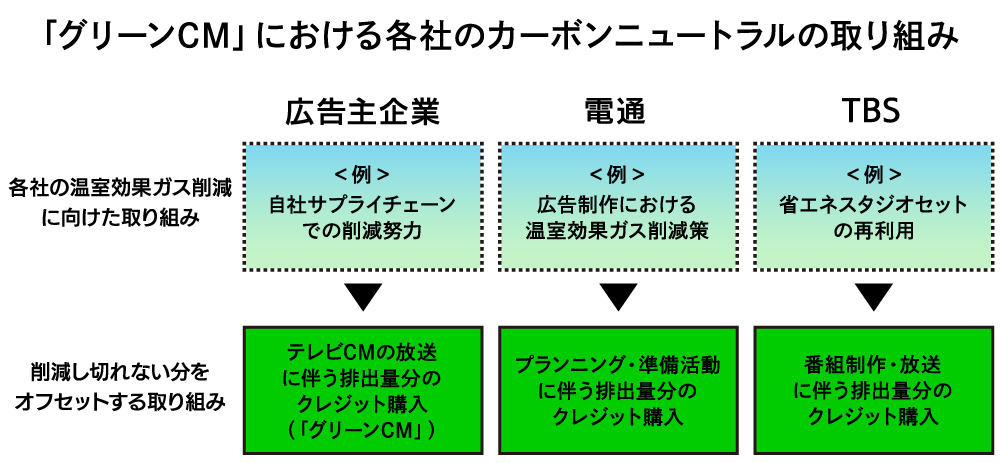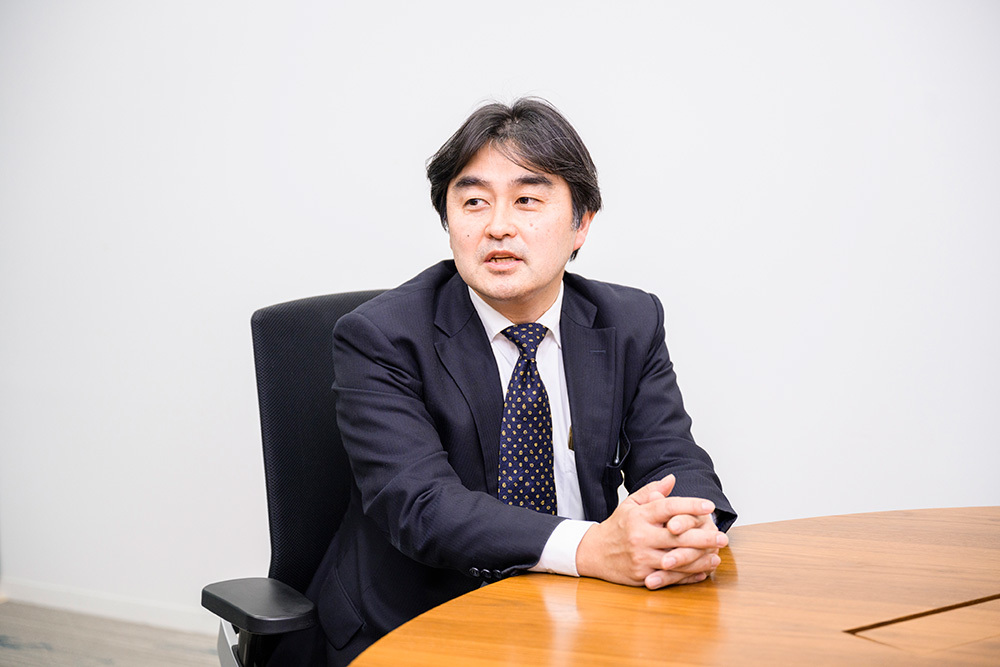Many companies and organizations are currently working to reduce greenhouse gas emissions.
This time, we introduce "Green CM," jointly developed by TBS Television, booost technologies, and Dentsu Inc. Advertising on carbon-neutral TV commercials also serves as a declaration of the advertiser's commitment to promoting carbon neutrality. We asked project members from the three companies about the background of this service.
Broadcasting a single TV commercial emits greenhouse gases equivalent to eight round trips between the UK and the US
──First, why is carbon neutrality required in advertising activities such as TV commercials? We asked Mr. Aoi, representative of booost technologies, which developed the Green CM scheme together with Dentsu Inc.
Aoi: Recently, companies have been accelerating their efforts to disclose their greenhouse gas emissions in order to achieve carbon neutrality. In Japan, companies listed on the Prime Market are effectively required to disclose information on climate change risks based on the recommendations of the Task Force on Climate-related Financial Disclosures (TCFD).
booost technologies operates and manages a platform that allows companies to measure and visualize how much greenhouse gases they emit in their business activities, set reduction targets and manage their progress toward those targets, and create reports for submission to external organizations.
Greenhouse gas emissions calculations are categorized into the following three scopes:
・"Scope 1" emissions: Direct emissions from the company's own operations
・"Scope 2" emissions: Indirect emissions from the use of electricity, heat, or steam supplied by other companies
・Other indirect emissions: "Scope 3"
Emissions associated with advertising and promotional activities primarily fall under Scope 3.
Yomaru: TV commercials involve two phases: production and broadcast. The former generates greenhouse gases during prop creation and disposal, as well as from travel to filming locations. The latter involves emissions from electricity consumption during broadcast.
It is said that reducing all of these Scope 3 emissions immediately is difficult from the perspective of cost and time. For tech companies, which have few direct emissions from industrial processes such as fuel combustion but many advertising opportunities, how to reduce Scope 3 emissions is an important issue.
This green commercial is a solution that focuses on the greenhouse gases emitted during the television commercial broadcast phase. Regarding commercial production, the Dentsu Group is collaborating with several companies to develop a solution called "Metaverse Production," which aims to reduce greenhouse gases by creating CG art sets and compositing them in the studio using separately shot live-action backgrounds ( see here for details ).
Aoi: Incidentally, it is said that broadcasting a single 30-second TV commercial emits the same amount of greenhouse gases as flying back and forth between the UK and the US eight times. When you think about it that way, reducing emissions from advertising and promotional activities is an initiative that has a huge impact not only on companies but also on the planet.
Aoi: Mr. Ito, you work in the Sales Division at TBS Television. What kind of initiatives are television stations advancing?
Ito: Achieving carbon neutrality is also a key focus for us at the television station.
TBS Television has set a concrete goal: to achieve carbon neutrality for Scope 1 and Scope 2 emissions at our three main facilities by fiscal year 2023. The Akasaka Sacas Cultural Facility and TBS Midoriyama Studio already use 100% renewable electricity. This fiscal year, we will extend this to our headquarters and the broadcasting center, which houses studio functions. We are also creating opportunities for people of all ages to think about the SDGs, such as planning the SDGs campaign "WEEK to Make the Earth Smile."
Akiyama: Dentsu Inc. thought about whether it could provide the world with a service that goes one step further toward achieving carbon neutrality, together with TBS Television, which has long been focused on reducing greenhouse gas emissions. So, with the cooperation of booost technologies, a climate tech company that develops and operates a CO2 emissions management and accounting platform, the three companies jointly planned "Green CM."
The act of placing a Green CM itself becomes a statement of the company's commitment to carbon neutrality.
──What exactly is the Green CM service?
Yomaru: It's a scheme where we calculate the greenhouse gas emissions associated with broadcasting TV commercials based on the internationally recognized GHG (Greenhouse Gas) Protocol calculation standards, purchase J-Credits equivalent to the emissions on behalf of the advertiser, and then have the advertiser purchase them.
J-Credits are a system certified by the government that treats reductions and absorptions of greenhouse gases as "credits." We believe that each company is already implementing measures to reduce greenhouse gases, but the idea is to offset the amount that cannot be reduced by purchasing credits. By utilizing this scheme, advertisers can work toward "carbon neutrality in TV commercials."
Tanagawa: Dentsu Inc. purchases credits for the emissions associated with the planning and preparation of green commercials. TBS Television contributes to achieving carbon neutrality alongside advertisers by purchasing credits for the emissions associated with the electricity used to broadcast commercials (*1).
Ito: In addition, for the mini-slot "Seventeen Goals: What We Can Do for the Future" that aired the green commercials, we measured the CO₂ emissions from program production and offset them by purchasing credits to achieve carbon neutrality.
*1 Electricity usage per commercial broadcast time at the TBS Broadcasting Center and Tokyo Sky Tree.

──You mentioned purchasing credits for emissions that cannot be reduced. How does booost technologies specifically calculate those emissions?
Aoi: The GHG Protocol stipulates a method of calculation based on multiplying the total advertising expenditure by a coefficient. In accordance with this international rule, we calculate the emissions to be offset based on advertising expenditure, and booost technologies purchases the corresponding credits on behalf of the advertiser.
Ito: As the first step in this initiative, we secured the support of four companies as sponsors and actually aired green commercials during the period from November 1 to 29, 2022, on the TBS TV program "Seventeen Goals: What We Can Do for the Future." This program is a documentary that supports people working on SDGs, and we announced within the program that "environmentally conscious green commercials will be aired."
What are the benefits for companies that place ads in green commercials?
Akiyama: First, for companies aiming to reduce Scope 3 emissions, the ability to contribute to carbon neutrality by offsetting emissions based on international rules is a major benefit. Furthermore, the very fact that they are advertising in green commercials as advertisers signals their intention to conduct environmentally conscious advertising and promotional activities, which I believe also has PR/IR benefits.
Tanagawa: We have received feedback from companies that have actually placed ads, saying that they would like to actively consider new proposals related to SDGs in other media as well, not just TV commercials.

The day when carbon neutrality becomes the standard for media is approaching.
──Please tell us about your future plans and challenges for developing green commercials.
Ito: At TBS Television, we feel that the first step is to raise awareness of green commercials. Our immediate plan is to make all commercials aired during "WEEK to Make the Earth Smile," which introduces SDGs initiatives in Japan and around the world with the participation of TBS Television's content production companies and programs, green commercials. Furthermore, in the future, we aim to make green commercials a natural part of everyday advertising activities. We want to gradually expand our activities while discussing with advertisers.
Aoi: Just like dieting, in order to reduce emissions, it is important to first accurately understand how much we are emitting. Not just for a single commercial, but for each product, service, and component. At booost technologies, we want to utilize the power of technology to present this information accurately and in an easy-to-understand manner.
Yomaru: The definition of a "good company" is currently undergoing a major change. A company that simply makes a profit is not necessarily a good company. A "good company" is one that can fulfill its non-financial responsibilities, such as those related to the global environment, local communities, and working conditions. This time, we developed a service focused on the global environment from the perspective of greenhouse gas emissions, but we would like to work with everyone to develop media solutions that are linked not only to the environment but also to non-financial information such as whether the company contributes to the local community and whether employee engagement is high.
Akiyama: We are still learning ourselves, but I think it's important for everyone to understand that the world is moving in this direction through domestic and international initiatives such as the J-Credits we discussed today. I believe green commercials can help raise public awareness of carbon neutrality, and as someone involved in advertising, I intend to continue spreading this message with a sense of mission.
Tanagawa: I believe that the day will come when carbon neutrality initiatives become standard across all media, not just TV commercials, but also radio commercials, newspapers and publications, outdoor advertising, sporting events, and so on.
From Dentsu Inc.'s perspective, we want to promote transformation into media that advertisers are more likely to choose, centered on the activities of MCx (Media & Content Transformation Project) (*2), in order to support the business growth of not only advertisers, but also broadcasters and partner companies, and contribute to the growth of society as a whole.
※2 MCx: A virtual organization spanning Dentsu Inc.'s various media content divisions. Launched in January 2021 with approximately 70 participants from Dentsu Group companies. It aims to develop cross-departmental solutions to address common media challenges. It also plays a central role in driving ONE MC, which aims to develop integrated MC solutions and platforms. This initiative seeks to enhance Dentsu Inc.'s competitiveness while maximizing revenue growth in the MC domain.




















